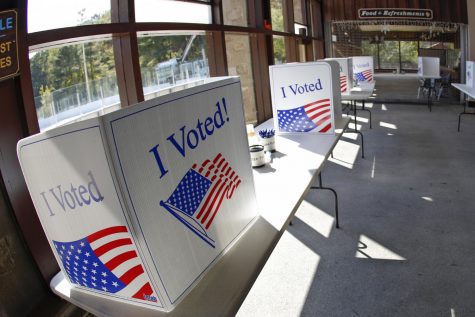MoCP virtual panel explains the indicators of voter suppression
October 12, 2020

As Election Day creeps closer, voters, politicians and pundits speak increasingly of voter suppression and voter fraud. At a recent panel discussion at the Museum of Contemporary Photography, experts weighed in on the hype, scare tactics and the legitimate threats to voting rights.
“There is a lot of hype out there about vote-by-mail supposedly being a threat relating to voter fraud,” said Ami Gandhi, senior counsel for the Chicago Lawyers Committee for Civil Rights. “[But] there are not facts to back up those claims.”
Gandhi sat on a virtual panel hosted by the Museum of Contemporary Photography Thursday, Oct. 8, to explain voter suppression and voter fraud as they relate to the upcoming presidential election.
Sharon Bloyd-Peshkin, co-curator of the museum’s new exhibit “What Does Democracy Look Like?” and associate professor in the Communication Department, moderated the panel.
Recently, the increased popularity of mail-in voting has stirred conversation about the possibility of voter fraud. During the Sept. 29 presidential debate, President Donald Trump said mail-in voting would lead to a “fraud like no one has ever seen,” as reported by the Chronicle Sept. 30.
However, Gandhi said mail-in ballots should wholeheartedly be considered valid.
“There’s been this torrential kind of attack on what is a pretty basic idea—that if someone feels comfortable to vote by mail because of [coronavirus risks], then their vote should be counted,” Gandhi said.
She said Illinois is in a good position for this election when it comes to voting by mail, as the state already has experience administering and handling mail-in ballots.
Brian X, a program manager and community organizer for Chicago Votes, a group that works to encourage youth to be civically engaged, said the term “voter fraud” is used as a scare tactic to try and prevent young people in particular from voting.
“Trying to get the youth out to vote was already pretty difficult,” X said during the panel. “And now on top of that, nationally, all you hear everyday is ‘voting by mail will lead to voter fraud.’”
But, the term “voter fraud” does have a place in the conversation about voter suppression, said José Morales Jr., deputy director of voter protection at Fair Fight Action, a national voting rights organization based in Georgia.
“Why are they erecting so many barriers [to voting]?” Morales said. “It’s because your vote is extremely powerful. The very act of stuffing that bad boy in an envelope and sending it is extremely powerful and a threat to [politicians’] very existence.”
Morales said there is more to voter suppression, including insufficient options to safely submit a vote in some locations, voters being kicked off voter registration rolls, polling places being consolidated and wait times being increased.
More poll workers are needed to prevent voter suppression, Morales said, especially those who are multilingual and from a diverse group of racial backgrounds.
“Sometimes just seeing people who look like you at the polls makes a difference,” Morales said. “Having a democracy cheer squad can really make someone remember what they’re doing this for.”
The panelists said voters can call 866-OUR-VOTE if they believe their vote is being suppressed, if they want to be a poll worker or for more information about voting.
The “What Does Democracy Look Like?” exhibit features photographs chosen by the curators to explain democracy in a visual sense from throughout history. The photographs are currently on display, and the exhibition runs through Dec. 23 at the Museum of Contemporary Photography, 600 S. Michigan Ave.







